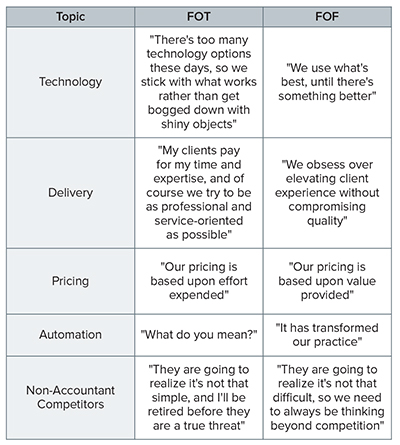Firm Journey | Winter 2019
When Worlds Collide: The CPA’s Future Is Now
Non-CPAs are increasingly influencing the accounting industry. So, what can CPAs do about it?

Tim Jipping, CPA, CGMA
Owner, Journey Advisors & CPAs
Navigating the Accounting and Consulting Landscape
How often do we talk about the firm of the future—the one that is three, five, and even 10
years out? What if I challenged that the firm of the future exists today? In fact, your firm is
one of them. Call me arrogant or call me naïve—you can even call me both. But I’d like to
argue that the game-changing differentiator between the firm of today and the firm of the
future is as simple as this: Discomfort.
You’ve read a paragraph and are probably convinced that I’ve lost it. Hear me out, and
consider a few things:
• Intuit now directly offers to consumers (our clients) software and cloud applications in
three core business areas of many CPA firms (bookkeeping, payroll, and tax).
• There are major software companies improving payroll administration to such a degree
that CPA firms could be pushed out of performing payroll services for good.
• The increasingly easy access to outsourced and even offshore bookkeeping outfits,
combined with advances in automation, are already resulting in fewer opportunities
for CPAs.
If you’re a CPA, these developments should make you uncomfortable. If you run a small or
midsize CPA firm, you should be concerned about what your future holds. And if you
happen to be in a large firm, don’t think you’re in the clear. The non-CPAs, and even non-accountants,
that are impacting our industry are making it easier for smaller firms to
compete with you as the attention of all CPAs must turn to providing more than just
traditional accounting, audit, and tax services. I predict that the more service displacement
we see in the near-term, the fiercer the competition between all firms will get.
THRIVING IN DISCOMFORT
The firm of the future is the uncomfortable firm. Adapters will win. The exponentially
increasing rate of disruption in our industry magnifies the importance of adaptability.
Adaptability, however, is not a one-time thing—it’s a continuous process, a consistent state
of being. Discomfort is a sign that a firm is aware of the challenges and disruptions around
it and that it is seeking to adapt in order to thrive.
In the martial art of Judo, the technique of Kuzushi is employed to deflect an attack and
use an opponent’s momentum against them in order to gain control over them. Rather than
putting energy toward resisting the changes in our profession, leaders in the firms of the
future embrace change as an opportunity and seek ways to exploit the competition of both
the non-CPAs and non-accountants entering our space.
How do you know if you’re a firm of the future or a firm of today? Here are a few examples
of how each firm might respond to a few relevant professional topics:

POSITIONING FOR SUCCESS
Not all the firms of today are going to die off—but I’m willing to bet
they’re not experiencing meaningful growth or crazy success. In
order to ensure you’re positioned for success as a firm of the future,
you’ll need to carefully examine your processes, services, and
business model.
Start by mapping out your processes, from onboarding clients to
service delivery. Don’t document what SHOULD be happening;
document what IS happening. Think of the following: How do you
onboard new clients and load them into your platform? How do you
define and communicate expectations? Are your clients clear on
what will be required of them? How do you obtain the necessary
information from clients, and how is it distributed to your team?
Have priorities and timelines been properly established and
communicated? Do you know if you’re on schedule? Do you have
defined deliverables? How do you collect payment? What are the
routine bottlenecks and obstacles in your processes? Can
automation, increased training, improved communication, fewer
touch points, or additional people be solutions?
Next, examine your services. How much of what you do falls into
the compliance category? Realize today that compliance work will
only continue to become more automated, offering less work (and
declining revenue) for CPAs in the future. You must begin to
determine how you can spice up your services to be value-focused
versus compliance-focused. Consider a few of these examples:
• Shift your focus to tax planning versus tax preparation (and
charge a premium for it!).
• Provide a few observations and insights with clients’ monthly
financials.
• Leverage reporting software to elevate your deliverables and
provide more insight.
• Begin communicating to clients how they compare to industry
peers and benchmarks.
• Proactively introduce clients to new tools or approaches that
could help them achieve their goals (ahem, you’d first have to
understand what their goals are to do this, by the way, which is
another client engagement opportunity).
Finally, examine your business model. Your firm’s structure could
be in direct opposition to its goals. For example, while your
expertise may be in business tax planning and compliance, over
the years you may have taken on a substantial amount of payroll
administration for your business clients. But payroll administration
is never ceasing, and the revenue-per-hour ratio is not all that high,
which could make it difficult to grow your practice in other areas
without making some structural changes.
It’s not at all uncommon for client relationships to be in the hands
of one individual or a small handful of staff, thereby consuming
significant chunks of their time and creating bottlenecks.
Intentionally shifting points of contact early on in a client relationship
could improve service delivery and client experience, while also
elevating your team’s ability to serve and communicate with clients.
This may require more structured training for your team, or even
enhanced titles for your team members to improve the client’s
perception of their point of contact.
Also consider creative measures to incentivize your team’s
performance. And when I say creative, I don’t mean off-the-shelf
bonus plans—think profit sharing based on performance metrics or
establishing an employee-owned entity designed to attract and
grow a certain niche. Remember, you didn’t get to where you are
alone, and you certainly won’t emerge as a successful firm of the
future alone.
I contend that adaptability, flexibility, and creativity will be the keys to
success for firms of the future. With firm size and structure having a
lot to do with how adaptable, flexible, and creative you can be, I think
small and midsize firms can realize the greatest opportunities for
success as non-CPAs and non-accountants disrupt our industry. If
you can get comfortable being uncomfortable, then becoming a firm
of the future is about continually reimagining your firm of today.